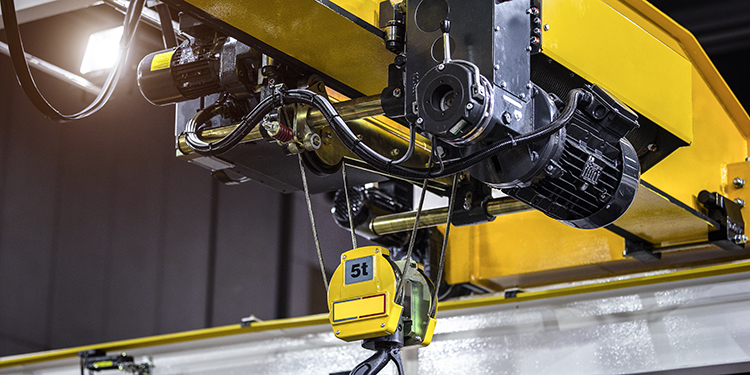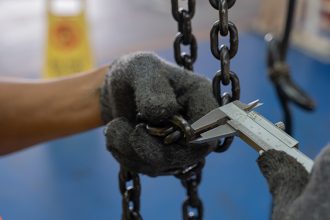
Like the brakes on a car — which slow, stop, and hold the vehicle in place as its motor continues to run — so too must an overhead crane be equipped with bridge and trolley brakes for safe load handling. In addition to helping maintain control of the load and reducing the risk of it striking personnel, brakes reduce wear and tear on the bridge and trolley by preventing the load from running into facility or runway structures, the crane itself, or other equipment.
Bridge and trolley brakes work by retarding or stopping travel either by means of friction or power. They come in two primary types:
- Holding brakes, which automatically prevent motion when the power is turned off.
- Control brakes, which reduce speed either by removing energy from a body in motion, or by imparting energy in the opposite direction of motion.
Both types of brakes must be properly sized in accordance with the rated speed and rated load of the system, as well as with the rated motor torque and the combined weight of the overhead equipment and its components.
The ability to slow, stop, and hold a load suspended overhead is so critical that requirements for bridge and trolley brakes are covered by multiple specifications. These include provisions published by the Occupational Safety and Health Administration (OSHA) in its specification OSHA 1910.179 – Overhead and Gantry Cranes, Section 1910.179 (f)(4); the American Society of Mechanical Engineers (ASME) in both AMSE B30.2 – Overhead and Gantry Cranes (Top Running Bridge, Single or Multiple Girder, Top Running Trolley Hoist) and ASME B30.12 – Cranes and Monorails With Underhung Trolley or Bridge; and the Crane Manufacturers Association of America (CMAA) in Specification 70 – Multiple Girder Cranes and Specification 74 – Single Girder Cranes.
While there is some slight variation between the requirements of these standards, all three organizations recommend or require properly sized bridge and trolley brakes be included on both powered cranes and hoists. The stipulations include:
- When sizing the brakes, they must be adequate to ensure that the bridge and trolley come to a full stop within a distance equal to 10% of the rated load speed when traveling at rated speed with a rated load. For example, a bridge or trolley capable of traveling at a speed of 120 feet-per-minute must be equipped with brakes that can stop its motion within 12 feet.
- When at rest, the bridge and trolley brake must be sized to resist:
- A horizontal force equal to 1% of the combined weight of the bridge, hoist, trolley, and rated load for the bridge brake; or
- A horizontal force equal to 1% of the combined weight of the hoist, trolley, and rated load for the trolley brake; or
- A horizontal force equal to 50% of the rated motor torque for indoor service or 100% of the rated motor torque for outdoor service, whichever is greater.
- Control braking is an applicable means of braking, as long as a holding brake is employed during times of power loss.
- Non-coasting mechanical drives are an acceptable means of braking, except on cab cranes as long as the stopping distance and holding requirements detailed above are met.
Best Practices for Bridge and Trolley Brakes
As with all overhead handling equipment, it is critical that every operator is thoroughly trained on the system and how to properly apply bridge and trolley brakes. Additionally, because the braking function performs differently in a loaded versus unloaded state — or under different load types — operators should be trained in a variety of alternative load handling scenarios to ensure they can safely slow, stop, and hold the equipment as it is being used.
The function of all brakes should be tested prior to the beginning of each shift. Any operational failures or deficiencies (such as excessive drift) should be reported to a supervisor, manager, or equipment owner, and the system should be removed from service until the proper repairs can be completed. Further, all trolley and bridge brakes should be inspected in alignment with the manufacturer’s recommendations, as well as per the requirements of OSHA, ASME, and CMAA.
Looking for additional best practices for the safe operation and use of overhead lifting equipment? The Overhead Lifting Best Practices Guide is offered as a free download from the members of the Overhead Alliance: the Crane Manufacturers Association of America (CMAA), Hoist Manufacturers Institute (HMI) and the Monorail Manufacturers Association (MMA). The document was developed by the group’s Service and Safety Committee in collaboration with OSHA through the Crane, Hoist and Monorail (CHM) Alliance. Through this partnership, the organizations provide information, guidance and access to training resources that help protect the health and safety of worker using hoists, cranes, and monorails.



